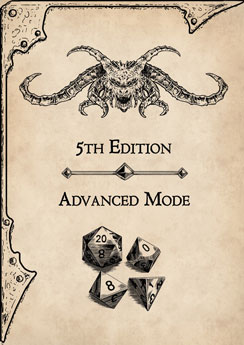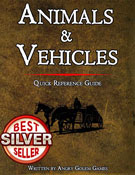Large monstrosity, unaligned
Armor Class 13 (natural armor)
Armor Class (suggested) 18 (frontal), 13 (natural armor)
Hit Points 51 (6d10 + 18)
Speed 30 ft., climb 30 ft.
Proficiency Bonus +2
Proficiency Bonus +3 (5th Edition Advanced Mode)
| STR | DEX | CON | INT | WIS | CHA |
|---|---|---|---|---|---|
| 14 (+2) | 13 (+1) | 16 (+3) | 1 (-5) | 12 (+1) | 5 (-3) |
Saving Throws (suggested) Con +5
Skills Perception +3
Senses darkvision 60 ft., passive Perception 13
Languages –
Challenge 2 (450 XP)
Keen Smell. The carrion crawler has advantage on Wisdom (Perception) checks that rely on smell.
Spider Climb. The carrion crawler can climb difficult surfaces, including upside down on ceilings, without needing to make an ability check.
ACTIONS
- Multiattack. The carrion crawler makes two attacks: one with its tentacles and one with its bite.
- Multiattack (suggested). The carrion crawler makes two type of attacks: eight with its tentacles or one with its bite.
- Tentacles. Melee Weapon Attack: +8 to hit, reach 10 ft., one creature. Hit: 4 (1d4 + 2) poison damage, and the target must succeed on a DC 13 Constitution saving throw or be poisoned for 1 minute. Until this poison ends, the target is paralyzed. The target can repeat the saving throw at the end of each of its turns, ending the poison on itself on a success.
- Tentacles (suggested). Melee Weapon Attack: +8 to hit, reach 10 ft., one or more creature. Hit: The target must succeed on a DC 13 Constitution saving throw or become poisoned for 2d4 rounds. While poisoned in this way, the target is also paralyzed. The target can repeat the saving throw at the end of each of its turns, ending the effect on a success.
- Bite. Melee Weapon Attack: +4 to hit, reach 5 ft., one target. Hit: 7 (2d4 + 2) piercing damage.
5th Edition Advanced Mode
Limiting the power of a character and making the overall difficulty of the game harder, does not reduce the creativity, indeed it does quite the opposite.
The Game Master has the option to use any and all of the instances proposed in this guide, or just some of them according to their preference.
It is the lack of something that move and motivate characters, not the abundance of it
DESCRIPTION
A Carrion Crawler is a monstrous creature that resembles a giant caterpillar with a squid-like head. It has a long, segmented body covered in chitinous plates and bristles, and a pair of mandibles that can deliver a powerful bite. Its most distinctive feature is the cluster of eight tentacles that sprout from below its mouth, each tipped with a venomous barb. These tentacles are used to paralyze and subdue prey, as well as to sense the smell of rotting flesh from far away.
Carrion Crawlers are usually pale green or yellow in color, but some may have darker or lighter patterns depending on their environment. They have large, bulbous eyes that can see in the dark, and a pair of antennae that help them navigate their surroundings. They can grow up to 15 feet long and weigh up to 500 pounds.
Carrion Crawlers are much-feared denizens of the underground world. They live in lairs, venturing out in search of carrion or food every few days. Some underground inhabitants such as goblins and trolls will make use of Carrion Crawlers by leaving the bodies of dead foes out in designated areas. This keeps the creatures at a good distance from their own homes and encourages them to “patrol” certain areas. Some orcs have been known to chain live prisoners near the lairs of these fearsome monsters.
The Carrion Crawler may well be the result of genetic experimentation by a mad, evil wizard, as it is a hybrid of a giant worm and a cephalopod. Like so many other hybrid monsters, the Carrion Crawler has no natural place in the world and is driven by two urges: food and reproduction.
COMBAT
Carrion Crawlers are opportunistic hunters and scavengers that prefer to feed on carrion, but will attack living creatures if they are hungry or threatened. They are not very intelligent, but they have a keen sense of smell and can track down their food sources with ease. They often lurk in dark dungeons or forgotten battlefields, where they can find plenty of corpses to feast on.
When they encounter potential prey, Carrion Crawlers will try to surprise them by ambushing them from above or behind, using their spider climb ability to traverse difficult surfaces. They will then lash out with their tentacles, attempting to paralyze as many targets as possible with their poison. Once their prey is immobilized, they will move in for the kill with their bite, tearing off chunks of flesh and bone.
Carrion Crawlers are not very durable, and will flee if they are outnumbered or wounded. They will also avoid direct confrontation with larger or more powerful foes, unless they are desperate or cornered. They have no sense of loyalty or cooperation, and will not hesitate to abandon or cannibalize their own kind if it means survival.
Carrion Crawlers will sometimes live with a mate or in a small group numbering no more than 6. This does not mean that they cooperate in hunting, but merely share the same space and compete fiercely for the same food. If two crawlers have made a kill or discovered carrion, they will often fight over the food, sometimes killing one another in the process.
HABITAT / SOCIETY
Carrion Crawlers roam the underground realms in search of food. They have no fixed lair, but will sometimes use a secluded spot as a temporary resting place or a stash for their leftovers. They are territorial and will defend their hunting grounds from other scavengers or predators, but they have no concept of hierarchy or social structure.
Carrion Crawlers are not capable of speech or communication, except for some basic sounds such as hisses or growls. They have no culture or religion, and no interest in anything other than satisfying their hunger. They do not mate or reproduce in any conventional way, but instead spawn new offspring by shedding segments of their body that contain embryonic cells. These segments will eventually grow into new Carrion Crawlers over time.
The Carrion Crawler mates once a year. Several days after mating, the female will go off in search of a large kill. When she has found or killed an adequate food supply, she lays about 100 eggs among the carrion. The grubs hatch one week later and begin feeding.
Maternal care ceases once the eggs have been laid and it is not uncommon for eggs to later be eaten by the female who laid them. Females die a few weeks after laying their eggs, exhausted by the effort. Males live only a short time longer, having mated with as many females as possible. Grubs have been known to consume one another in feeding frenzies, and are a favorite food of adult Carrion Crawlers.
Few of the grubs reach maturity, but those who do have eaten voraciously and will achieve their full size in a single year. When they reach maturity, the mating cycle begins again.
ECOLOGY
Carrion Crawlers play an important role in the ecosystem of the Underdark, as they help decompose organic matter and recycle nutrients. They also serve as a food source for many other creatures, such as otyughs, ropers, or purple worms. However, they can also pose a threat to civilized races that dwell or venture underground, as they can spread diseases and parasites through their bites and droppings.
Carrion Crawlers have few natural enemies, as most predators avoid them due to their poison and foul smell. However, they can be hunted by adventurers or explorers who seek their venom for alchemical purposes, or their chitin for crafting armor or weapons. Some cults or necromancers may also use them for dark rituals or experiments, as they have an affinity for negative energy and undeath.
The Carrion Crawler provides the same useful, if disagreeable, function that jackals, vultures, and crows perform. Like so many other predators Carrion Crawlers instinctively prey on the weak, sick, and foolish. In the long run, this has a beneficial effect on the prey, strengthening its gene pool. The Carrion Crawler also works wonders in over crowded caverns, quickly eliminating population problems among the weaker monsters. Thus, the life cycle of the crawler is inextricably linked to those of its prey — when the prey flourishes so does the crawler.
Carrion Crawler is employed as material component to empower the following spells:
Carrion Crawlers can be used as mounts or pulling animals for vehicles.
The statistics are detailed in the D&D 5e Animals & Vehicles reference guide. Just have a look at the preview on DrivethruRpg.

